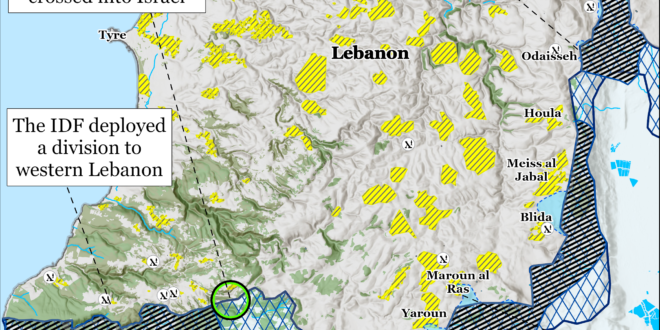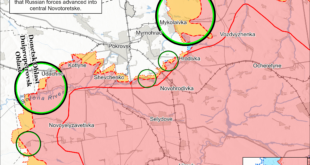Israeli political leaders indicated that the Israel Defense Forces (IDF) killed Hashem Safi ed Din—the presumed successor to Hassan Nasrallah—in an airstrike on Beirut on October 4.[i] Israeli Prime Minister Benjamin Netanyahu said in a video statement on October 8 that Israel killed “Nasrallah himself, and Nasrallah’s replacement, and the replacement of his replacement,” which Israeli media has framed as confirmation of the killing of Safi ed Din.[ii] Israeli Defense Minister Yoav Gallant similarly said on October 8 that the IDF probably killed Safi ed Din.[iii] IDF Spokesperson Rear Admiral Daniel Hagari, on the other hand, said that the IDF is still investigating the results of the airstrike targeting Safi ed Din.[iv] Hezbollah Deputy Secretary General Naim Qassem released a video statement on October 8 in which he said that Hezbollah would select a new leader based on its approving mechanisms, noting that the war made the succession to Nasrallah ”difficult and compromised.”[v] Qassem may be among the candidates considered to replace Nasrallah given that he has formal seniority in the organization and has appeared as the public face of the group in these difficult circumstances.
Netanyahu in his own video statement addressed the Lebanese people directly, saying that Hezbollah is “weaker today than it has been for many years.”[vi] Netanyahu asked the Lebanese people to “take back [their] country” from Hezbollah.[vii] Gallant similarly noted that Hezbollah is “without a leader” and that Israel should ”take advantage” of this situation in order to safely return displaced civilians to their homes in northern Israel.[viii]
Hezbollah Deputy Secretary General Qassem separately in his video statement praised Hezbollah’s resilience and vowed to continue attacks into Israel.[ix] Qassem described the Israeli killing of Nasrallah and other Hezbollah leaders as a ”painful blow” but said that new leaders have capably filled these vacant positions.[x] Qassem also observed that numerous Israeli cities are within the range of many Hezbollah weapons systems and said that Hezbollah would ”expand the ranges” of its attacks.[xi] Qassem separately tried to build domestic Lebanese support for Hezbollah by asserting that Hezbollah began attacking Israel in October 2023 to support the Gaza Strip and to “defend Lebanon and its people.”[xii]
Qassem also expressed Hezbollah supports for Lebanese Parliament Speaker Nabih Berri’s efforts to broker a ceasefire between Israel and Hezbollah.[xiii] Qassem did not condition Hezbollah support for a ceasefire on first securing a ceasefire in the Gaza Strip, as Nasrallah consistently did.[xiv] Qassem refrained from elaborating on what a ceasefire in Lebanon would involve. Berri, who is a Hezbollah political ally, has met recently with Arab, Iranian, and Western officials to discuss a potential ceasefire in Lebanon.[xv] A ceasefire would require Hezbollah to at least cease its near constant attacks that Qassem vowed to continue and expand in northern Israel.
The IDF deployed a fourth division—the 146th Reservist Division—to southwestern Lebanon on October 8 for “focused and delimited” ground operations against Hezbollah.[xvi] The 2nd infantry, 205th armored, and 213th artillery brigades are currently operating under the 146th Division.[xvii] This division joins the 91st, 36th, and 98th divisions in southern Lebanon shortly after Israel announced that it would expand ground operations against Hezbollah and created a new closed military zone in Western Galilee.[xviii] An Israeli military corresponded estimated that there are likely over 15,000 Israeli soldiers deployed to fight in southern Lebanon.[xix]
The IDF destroyed a Hezbollah tunnel that crossed the Israel-Lebanon border on October 8.[xx] The IDF stated that the rudimentary tunnel crossed into Israel near Zarit but that Israeli forces blocked the tunnel exit into Israel several months ago and had maintained “full operational control” over the area.[xxi] Israeli forces seized weapons, including anti-tank missiles, inside the tunnel.[xxii] The IDF added that it has not found any other Hezbollah tunnels that cross into Israel.[xxiii]
US Central Intelligence Agency Director William Burns said on October 7 that Iran could produce enough fissile material for a nuclear weapon in around a week.[xxiv] Burns also said that the United States has observed no evidence that Iranian Supreme Leader Ali Khamenei has ordered the regime to build a nuclear weapon. Burns added that the United States and its partners should be able to detect “relatively early on” if Iran begins building a nuclear weapon.
Key Takeaways:
- Lebanon: Israeli political leaders indicated that the IDF killed Hashem Safi ed Din—the presumed successor to Hassan Nasrallah—in an airstrike on Beirut.
- Lebanon: Lebanese Hezbollah Secretary General Naim Qassem lauded the resilience of Hezbollah and vowed to continue and even expand attacks into northern Israel.
- Lebanon: The IDF deployed a fourth division—the 146th Reservist Division—to southwestern Lebanon as part of its expansion of ground operations against Lebanese Hezbollah.
- Iran: US CIA Director William Burns said that Iran could produce enough fissile material for a nuclear weapon in around a week but does appear to have not yet made the decision to do so.
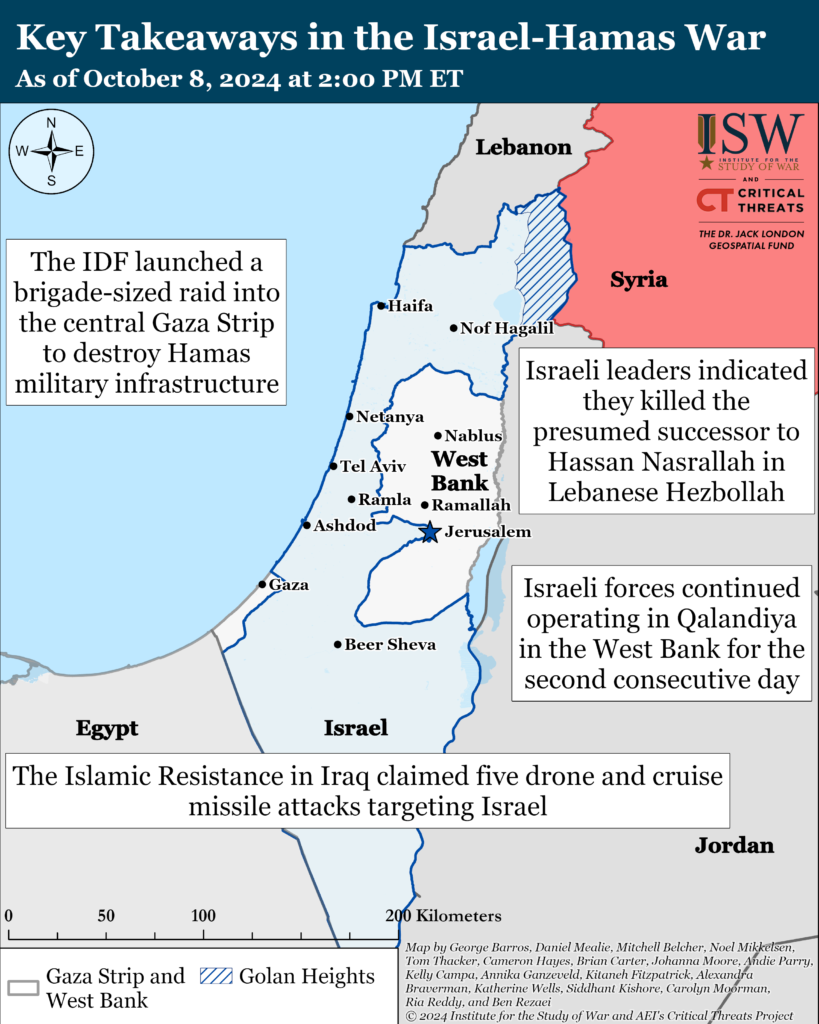
Gaza Strip
Axis of Resistance objectives:
Erode the will of the Israeli political establishment and public to sustain clearing operations in the Gaza Strip
Reestablish Hamas as the governing authority in the Gaza Strip
The IDF Air Force struck 70 unspecified targets on the Gaza Strip on October 8.[xxv]
An Israeli Army Radio correspondent reported on October 8 that the IDF “recently” killed three Hamas fighters who participated in the October 7, 2023, attack into Israel.[xxvi] The correspondent specified that one of the fighters participated in the attacks on Nahal Oz and Kfar Aza in southern Israel.[xxvii]
The IDF re-issued evacuation orders for Beit Hanoun, Jabalia, and Beit Lahiya in the northern Gaza Strip on October 8.[xxviii] The IDF reiterated its call for residents to travel to the al Mawasi humanitarian zone in the southern Gaza Strip via a single north-south road. The IDF had told residents to travel to al Mawasi via two north-south roads on October 7.[xxix]
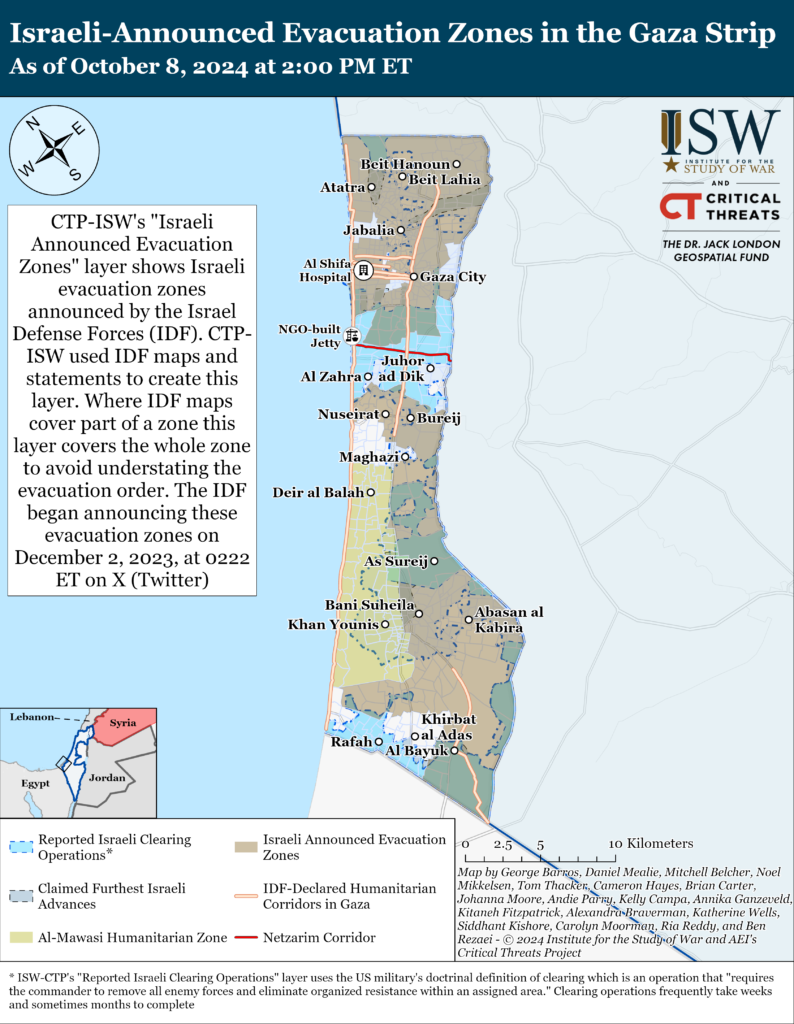
The IDF continued clearing operations in Jabalia refugee camp, Gaza City, on October 8 after launching a new operation there to disrupt Hamas reconstitution efforts. The IDF 162nd Division killed 20 fighters via airstrikes and close-quarters combat.[xxx] The IDF 401st Brigade destroyed a weapons depot and located a large quantity of weapons, including grenades and Kalashnikov rifles.[xxxi] The IDF 460th Brigade killed several Palestinian fighters in a building, who fired anti-tank missiles at Israeli forces.[xxxii] Multiple Palestinian militias, including Hamas and the al Aqsa Martyrs’ Brigades, fired mortars and small arms targeting Israeli dismounted infantry, armor, and command-and-control centers near Jabalia on October 7 and 8.[xxxiii]
The IDF announced a 17th Battalion soldier died in combat in Jabalia in the northern Gaza Strip.[xxxiv] Another 17th Battalion soldier was injured in the same incident. The 17th Battalion is subordinate to the 828th Bisalmach infantry training Brigade.[xxxv]
Palestinian militias launched five attacks targeting Israeli forces and command-and-control centers around the Netzarim Corridor on October 8.[xxxvi] The IDF 252nd Division operates along the corridor.[xxxvii]
The IDF continued operations in the central Gaza Strip on October 7. The 252nd Division destroyed Palestinian militia infrastructure and killed fighters in “targeted raids.”[xxxviii] An Israeli Army Radio correspondent said in June 2024 that the IDF would shift to a targeted raid approach in the whole Gaza Strip after the end of the Rafah operation.[xxxix] Israeli Minister Yoav Gallant said during a visit to Rafah on August 21 that the IDF 162 Division had defeated Hamas’ Rafah Brigade.[xl]
The IDF 14th Brigade Combat Team launched a raid targeting Palestinia militia fighters and infrastructure in Bureij on October 7.[xli] The IDF last operated in Bureij in early June 2024.[xlii] Palestinian militias, including Hamas and the al Aqsa Martyrs‘ Brigades, conducted multiple attacks targeting Israeli personnel and armor northeast of Bureij on October 7.[xliii]
The IDF continued operations in Rafah in the southern Gaza Strip on October 8. The IDF Air Force struck a Palestinian militia command-and-control site in Khirbet al Adas in northeastern Rafah on October 8.[xliv] The IDF Gaza Division operates in Rafah with its subordinate Bislach and Nahal brigades.[xlv]
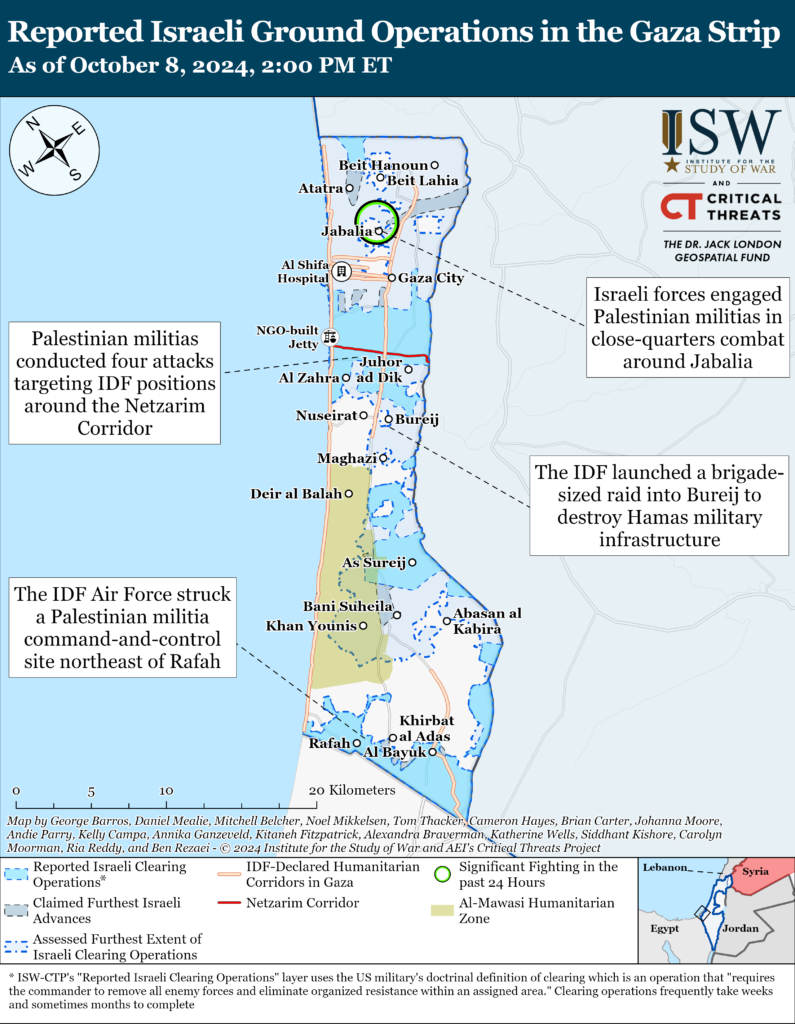
Palestinian Islamic Jihad (PIJ) fired two rockets targeting southern Israel on October 8.[xlvi] The IDF intercepted the rockets.[xlvii]
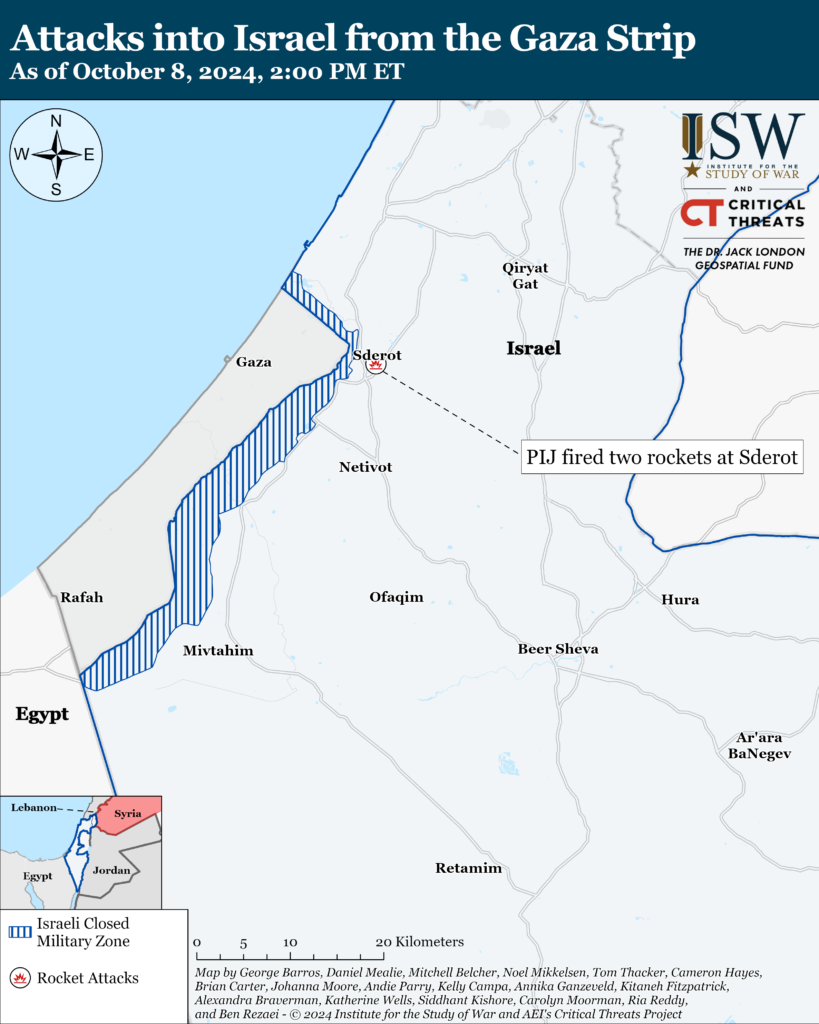
West Bank
Axis of Resistance objectives:
Establish the West Bank as a viable front against Israel
IDF Chief of Staff Lieutenant General Herzi Halevi conducted a situational assessment in the West Bank on October 8 to review how to prevent Palestinian militia attacks during the Jewish High Holidays.[xlviii] Halevi met with senior Israeli security officials, including the IDF 877th Division commander, to discuss the security situation and review Israeli forces’ readiness in the West Bank.[xlix] The Axis of Resistance and Palestinian militias have historically emphasized attacking Israeli targets during this period.[l]
Israeli forces continued operating in Qalandiya for the second consecutive day on October 8.[li] The IDF stated that it detained ten wanted individuals, seized five firearms, and confiscated an unspecified amount of “terrorist funds.”[lii] The IDF separately operated in Beit Ummar and interrogated “dozens” of Palestinians suspected of “terrorist activities.”[liii] The IDF also shot two Palestinians who threw “explosives” and Molotov cocktails at Israeli forces.[liv]
Northern Israel and Lebanon
Axis of Resistance objectives:
Deter Israel from conducting a ground operation into Lebanon
Prepare for an expanded and protracted conflict with Israel in the near term
Expel the United States from Syria
The IDF 36th Division continued clearing Hezbollah infrastructure around Maroun al Ras and other southern Lebanese towns on October 8.[lv] The IDF Golani Brigade cleared a Hezbollah compound that had a loaded rocket launcher overlooking northern Israeli border towns.[lvi] The forces also located and destroyed Hezbollah weapons reportedly meant to be used in ambushes against Israeli forces and attacks on northern Israeli towns.[lvii]
The IDF 98th Division continued clearing Hezbollah infrastructure around Odassieh and other southeastern Lebanese border villages on October 8.[lviii] The 98th Division has killed over 200 Hezbollah fighters along the border since beginning ground operations on October 1.[lix] The IDF 35th and 89th brigades engaged dozens of Hezbollah fighters at close range and destroyed underground Hezbollah infrastructure.[lx] Israeli forces have discovered stockpiles of new weaponry in boxes in the border villages.[lxi] An Israeli Army Radio correspondent reported the 98th Division has noticed that, compared to Hamas fighters in the Gaza Strip, Hezbollah fighters are more organized and are operating above ground with longer-range weapons systems.[lxii] The 98th Division led months of clearing operations targeting Hamas infrastructure in the Gaza Strip before deploying to Lebanon.[lxiii]
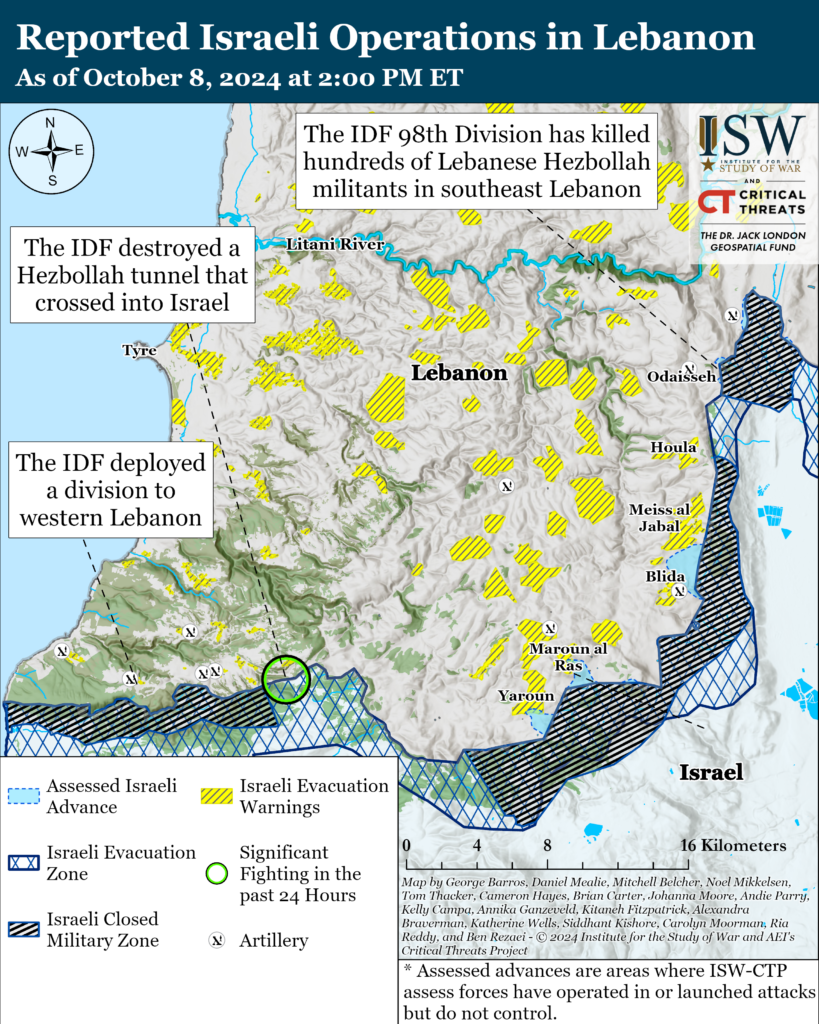
Hezbollah has conducted at least 13 attacks into northern and central Israel since CTP-ISW’s last data cutoff on October 7.[lxiv] Hezbollah launched over 110 rockets targeting Haifa—the largest rocket barrage to ever target the city.[lxv] The IDF Air Force struck several rocket launchers that Hezbollah used to fire rockets at Haifa.[lxvi] Hezbollah also attacked an IDF position north of Tel Aviv with five medium-range rockets.[lxvii] Hezbollah attacked Israeli forces near the southern Lebanon border with one-way attack drones.[lxviii]
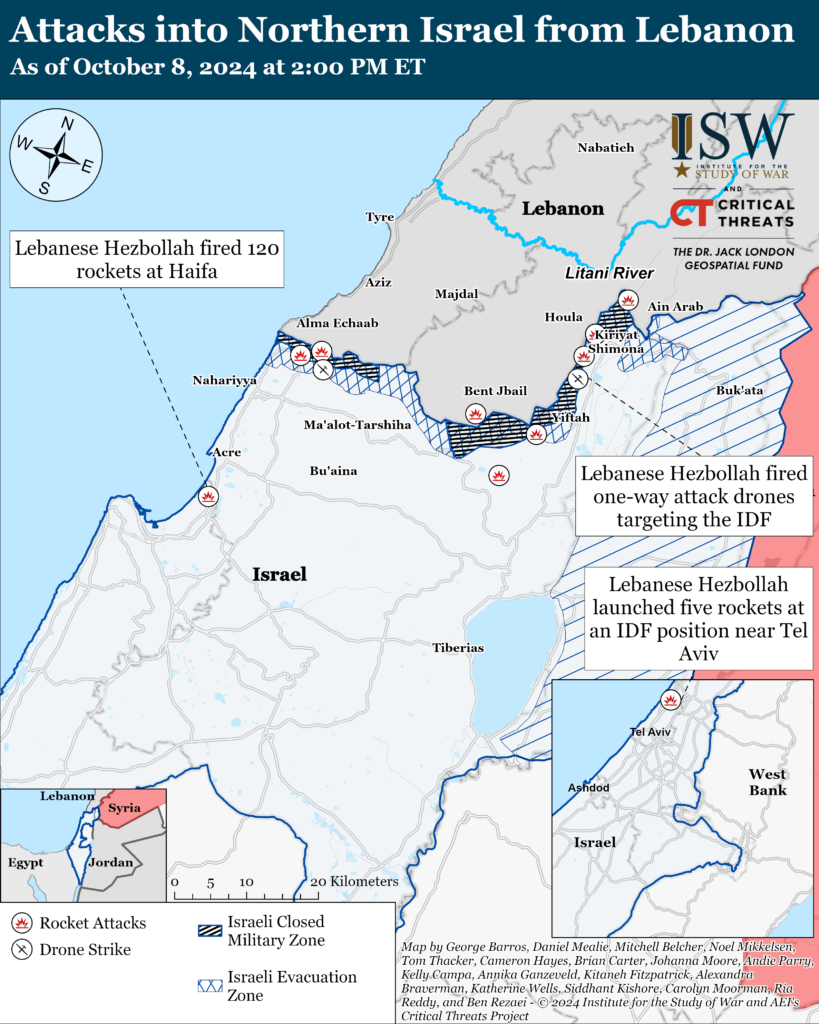
The IDF continued its air campaign targeting Hezbollah capabilities, leadership, and infrastructure. The IDF struck over 70 Hezbollah targets in southern Lebanon and the Bekaa Valley, including rocket launchers, command-and-control sites, and weapons depots.[lxix] The IDF also conducted multiple strikes targeting Hezbollah intelligence infrastructure and other targets in Beirut’s southern suburbs.[lxx] The IDF said it killed Hezbollah’s ”chief of staff” Suheil Hussein Husseini in Beirut on October 7.[lxxi] Husseini was a member of the Jihad Counci—Hezbollah‘s top military entity—and headed Hezbollah’s logistical unit, which oversees Hezbollah’s budgeting, weapons research development, and allocation of arms from Iran.[lxxii]
The IDF conducted a series of airstrikes on October 7 targeting underground infrastructure affiliated with Hezbollah’s southern regional commands.[lxxiii] The IDF said that the three units affiliated with Hezbollah’s southern front—the Nasr, Badr, and Aziz units—had established a wide network of underground infrastructure from which Hezbollah planned to target Israeli forces and towns in the event of fighting in Lebanon.[lxxiv] The IDF struck unit headquarters, infrastructure, and medium-range rocket systems across southern Lebanon. IDF Spokesperson Rear Admiral Daniel Hagari said that the IDF killed at least 50 Hezbollah fighters in the airstrikes, including six senior commanders in the Southern Front units.[lxxv]

This map illustrates individual Israeli air and artillery strikes based on local Lebanese reporting. This map depicts strikes reported from 2:00pm ET on October 7 to 2:00pm ET on October 8. This map is not exhaustive. CTP-ISW cannot independently verify the locations of Israeli strikes.
Iran and the Axis of Resistance
Iranian-backed Iraqi militias issued statements commemorating the one-year anniversary of Hamas’ October 7, 2023, attack into Israel. Kataib Hezbollah Secretary General Abu Hussein al Hamidawi called on the Islamic Resistance in Iraq—a coalition of Iranian-backed Iraqi militias—to continue conducting “concentrated strikes” targeting Israel and to “activate joint operations” with the Houthis.[lxxvi] CTP-ISW has reported extensively on how the Houthis and Iranian-backed Iraqi militias have increased military cooperation in recent months.[lxxvii] They started conducting combined attacks targeting Israel in June 2024.[lxxviii] A US self-defense strike in July 2024 targeting a prominent Iranian-backed Iraqi militia facility killed a Houthi drone expert who had traveled to Iraq to train other Iranian-backed Iraqi militias in drone tactics.[lxxix] Kataib Sayyid al Shuhada Secretary General Abu Ala al Walai separately claimed that Hezbollah is the “first support front” for the Gaza Strip and that Iraq has become the “first support front” for Lebanon and the Gaza Strip.[lxxx] Both Hamidawi and Walai criticized some Arab and Gulf countries for insufficiently supporting the Axis of Resistance in its fight against Israel, with Walai warning that Saudi Arabia and the United Arab Emirates are “not immune from punishment.”[lxxxi]
The Islamic Resistance in Iraq claimed five Arqab cruise missile and drone attacks targeting five unspecified locations in central and northern Israel on October 8.[lxxxii]
The Islamic Revolutionary Guards Corps (IRGC) denied reports that Israel conducted an attack in Esfahan on October 7.[lxxxiii] This statement follows social media reports of sounds of explosions heard in Esfahan and south of Tehran.[lxxxiv] An IRGC spokesperson said that the explosion sounds resulted from air defense tests.[lxxxv]
Anonymous sources told the New York Times that Israel will likely first strike Iranian military bases then possibly intelligence sites or key leadership in retaliation for the recent Iranian ballistic missile attack on Israel.[lxxxvi] The New York Times added that Israel will not likely strike Iranian nuclear sites.[lxxxvii] The report finally noted that Israel may attack the Iranian nuclear program if Iran escalates further.
 Eurasia Press & News
Eurasia Press & News
